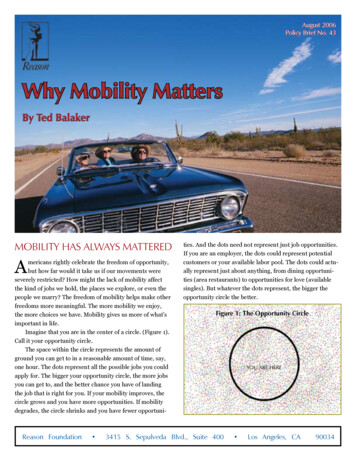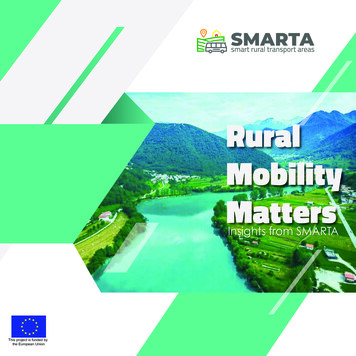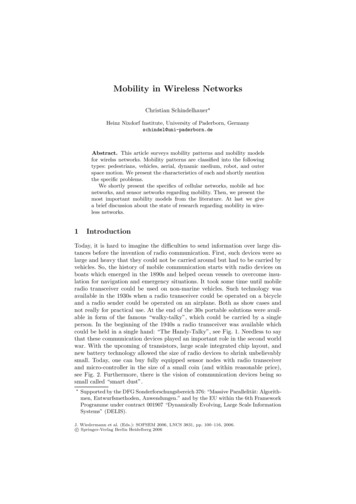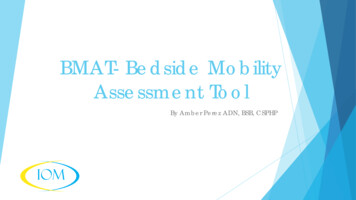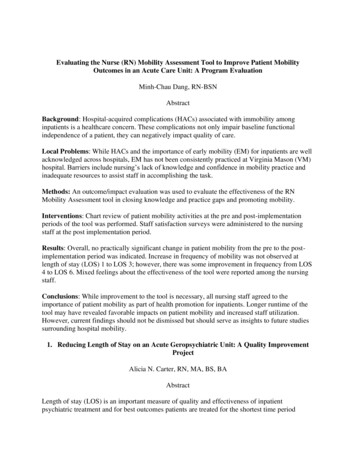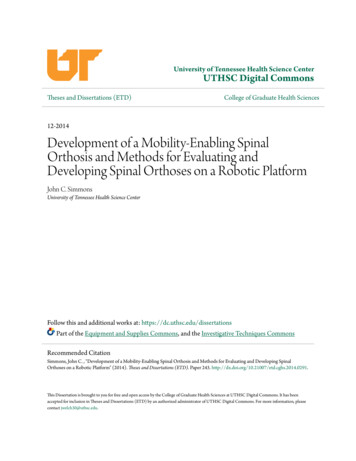
Transcription
University of Tennessee Health Science CenterUTHSC Digital CommonsTheses and Dissertations (ETD)College of Graduate Health Sciences12-2014Development of a Mobility-Enabling SpinalOrthosis and Methods for Evaluating andDeveloping Spinal Orthoses on a Robotic PlatformJohn C. SimmonsUniversity of Tennessee Health Science CenterFollow this and additional works at: https://dc.uthsc.edu/dissertationsPart of the Equipment and Supplies Commons, and the Investigative Techniques CommonsRecommended CitationSimmons, John C. , "Development of a Mobility-Enabling Spinal Orthosis and Methods for Evaluating and Developing SpinalOrthoses on a Robotic Platform" (2014). Theses and Dissertations (ETD). Paper 243. http://dx.doi.org/10.21007/etd.cghs.2014.0291.This Dissertation is brought to you for free and open access by the College of Graduate Health Sciences at UTHSC Digital Commons. It has beenaccepted for inclusion in Theses and Dissertations (ETD) by an authorized administrator of UTHSC Digital Commons. For more information, pleasecontact jwelch30@uthsc.edu.
Development of a Mobility-Enabling Spinal Orthosis and Methods forEvaluating and Developing Spinal Orthoses on a Robotic PlatformDocument TypeDissertationDegree NameDoctor of Philosophy (PhD)ProgramBiomedical EngineeringResearch AdvisorDenis J. DiAngelo, Ph.D.CommitteeEugene C. Eckstein, Ph.D. Richard J. Kasser, Ph.D. Gladius Lewis, Ph.D. Teong E. Tan, Ph.D.DOI10.21007/etd.cghs.2014.0291This dissertation is available at UTHSC Digital Commons: https://dc.uthsc.edu/dissertations/243
Development of a Mobility-Enabling Spinal Orthosis and Methods for Evaluatingand Developing Spinal Orthoses on a Robotic PlatformA DissertationPresented forThe Graduate Studies CouncilThe University of TennesseeHealth Science CenterIn Partial FulfillmentOf the Requirements for the DegreeDoctor of PhilosophyFrom The University of TennesseeByJohn C. SimmonsDecember 2014
Copyright 2014 by John C. Simmons.All rights reserved.ii
ACKNOWLEDGEMENTSThere are many to thank for this opportunity to do advanced research. I wouldlike to thank my research advisor, Dr. Denis DiAngelo for all of the support and patienceas well as for providing, along with Dr. Brian Kelly, a remarkable program andlaboratory where great research can happen. I would also like to thank my committee forboth their advice and their encouragement. Dan Wido was skilled and patient as he taughtseveral of us how to use and program the robot. Hunter Smith has no idea how much Ilearned from him. I suppose he had to graduate but he is greatly missed. Kelly Salb andCharles (Chad) Bennett actually understood the inner workings of things too deep for meand were willing to help. Clay Hillyard has also been a great help and a pleasure to workwith. I am also grateful for the University of Tennessee Research Foundation maturationgrant that helped pay expenses for this research. The work in this study was madepossible by the robotic platforms and protocols provided by the BioRobotics Laboratoryin the Department of Orthopaedic Surgery and Biomedical Engineering. Thank you all.iii
ABSTRACTIntroduction: A number of decompressing spinal braces (typically pneumatic) havebeen introduced that attempt to mechanically emulate the “buoyancy” of water therapy byoffloading upper torso load to the pelvic girdle as a treatment for lower back pain (LBP).Unfortunately, the beneficial upward force they apply on the upper torso typically makesit difficult or impossible for the patient to bend. For those cases where stabilization is notindicated, this undesirably hinders therapeutic exercise, independent living, and return towork. The cosmetic stigma of wearing an external pneumatic assembly large enough toprovide significant offloading may provide additional disincentives to user compliance.Also, there was not, to our knowledge, a scientific orthosis evaluation and developmentplatform capable of producing orthoses with predictable effects on spinal loads. Researchobjectives were thus to a) develop an advanced robotic test platform (RTP) for the rapiddevelopment of spinal orthoses, b) use the RTP to evaluate a commercial decompressingorthosis, c) design, build, and test on the RTP a new orthosis that provides distractiveforce while enabling mobility, and d) compare the test results of the new orthosis and thecommercial decompressing orthosis.Method: Responsive to the unmet needs for an offloading spinal orthosis that permitsmobility, a new conceptual design for a decompressing spinal orthosis was developed.The acronym START was used because it was intended to provide Spine TractiveAdjustment with Rotational Tolerance. The spine tractive adjustment was intended toallow caregivers to selectively reduce or completely eliminate load upon the lumbarspine. The rotational tolerance facility was designed to provide the wearer freedom ofmotion within an optionally enforced caregiver-assigned range. The new experimentalSTART components were designed to be lightweight and concealable under ordinaryclothing.There was also a need for an evaluation and rapid development platform capableof producing and evaluating orthoses with a predetermined capacity to accomplishspecific clinical objectives (e.g., to apply distractive force). The BioRobotics Laboratoryin the Department of Orthopaedic Surgery and Biomedical Engineering at The Universityof Tennessee already had an advanced robotic testing platform (RTP). Software protocolsfor simulating daily living activities (DLA’s) on human body parts with the RTP werealready in use. The software was then modified to simulate gravitational loads duringtorso flexion and extension. Also, a human analogue, comprising upper and lower torsosegments, was fabricated. The two analogue components were then connected by abiomimetic spine. These were designed and developed to simulate the responses of ahuman torso under RTP-simulated gravitational loads during the execution of DLA’s.The human analogue with biomimetic spine was mounted in the RTP. An orthosis to betested was strapped to the human analogue as it would be to a living body. The RTPorchestrated the physiologic simulation of the lumbar spine loading mechanics of DLA’supon the human analogue (e.g., upright neutral stance, initiation of flexion, and initiationof extension). Load cells recorded the RTP-applied forces and moments as well as theforces and moments at the base of the lumbar spine. The START orthosis and aiv
commercial spinal orthosis (The Orthotrac Pneumatic Vest) were tested for comparisonon the RTP in a limited range of sagittal flexion (5 ) and extension (3 ). Forces weretransformed to the sacral disc plane (SDP) which is essentially parallel to the inferiorsurface of L5. Also, sensors were placed between the orthoses to be tested and the humananalogue during tests to better understand pressures at the orthosis-skin interface.Measures of the rotational structural properties and spinal offloading capacity of theorthoses were analyzed.Results: In testing on the RTP, the maximum brace load (the brace’s supportivecapacity) for both orthoses was approximately 300 N. This is approximately enough tofully offset the upper torso weight of a person weighing approximately 750 N (169pounds). In one set of tests summarized here, the RTP-simulated gravity (applied load)was 300 N. The Orthotrac resisted extension at 3 of rotation with a moment ofapproximately 7.1 Nm compared to 5.5 Nm for the START. At 5 of flexion, momentresistance for the Orthotrac was approximately 18 Nm compared to 9.4 Nm for theSTART. Within the range of these tests, the START caused less bending resistance thanthe Orthotrac. The START orthosis was also tested at rotational ranges in excess of thosepossible with the Orthotrac (up to 28 of flexion and 10 of extension). In those tests(which also used an RTP-simulated gravity of 300 N) the START orthosis provided asignificant but declining brace load as these degrees of rotation increased. At 28 offlexion the brace load was approximately 172 N. After rotating 10 in extension thebrace load was approximately 247 N. At 28 of flexion the START orthosis’ resistanceto rotation was approximately 20 Nm. At this rotation, the approximate magnitude of therotational stiffnesses of the brace (0.4 Nm/degree) and the spine (0.5 Nm/degree) weresimilar and the magnitude of the rotational stiffness of the spine and brace together wasapproximately 0.9 Nm/degree. At 10 of extension the START orthosis’ resistance torotation was approximately 15 Nm.Discussion: The modified RTP protocol simulated gravitational forces and orchestratedmotion while repeatably measuring biomechanical properties useful for evaluating andcomparing orthoses. The human analogue and biomimetic spine made it possible toconduct comparative tests between unlike orthoses over an extended period of time. Also,pressure sensor measurements indicated the importance of managing the distribution offorce at the orthosis-skin interface.Conclusions: The compressive loading data indicate that both the Orthotrac and theSTART orthosis provided load support up to approximately 300 N. Both could be easilyadjusted to provide reduction of spinal load. Also, where needed, they can both beadjusted to more than offset the full spinal load (on persons whose body weight is lessthan approximately 169 pounds). The rotational stiffness data suggested that the STARTorthosis provided more wearer mobility than the Orthotrac based on significantly lessapplied moment required to bend in flexion. The RTP’s ability to predict the approximateloads that a given orthosis will support provides a means that may be used in the future asa rapid development platform for new and improved orthoses. It may also provide thefirst steps towards a classification means and a set of standards for spinal orthoses. Thisv
would better enable caregivers in the future to select and administer the orthoses bestsuited to specific LBP causative pathologies.vi
TABLE OF CONTENTSCHAPTER 1. INTRODUCTION .1CHAPTER 2. BACKGROUND.4Biomechanics of the Lumbar Spine .4Current Treatments .5Water Therapy.6Conventional Spinal Orthoses.6Decompressing Orthoses .9Clinical Issues .10The Plurality of Causative Pathologies .10The Gap Between the Clinical and Experimental Models .10Selection of a Commercial Decompressing Orthosis for Testing.14CHAPTER 3. METHODS.16Development of New Orthosis Concepts.16Body Engagement Mechanism .16Offloading and Mobility Enabling Components .17Adjustment Mechanisms for Distractive Force .19Rotational Tolerance .24Comfort and Safety .24First Physical START Model.25Platform and Protocol .25The Multi-Axis Robotic Testing Platform (RTP) .25Protocol and Force Analysis .26Data Management .29The Analog Model of the Lumbar Spine .31The Torso and Pelvic Girdle Assembly of the Human Analogue.32Pressure Measurement at the Orthosis-Skin Interface .32Orthotrac Tests .34START Tests .35CHAPTER 4. RESULTS .37Platform and Protocol .37The Multi-Axis Robotic Testing Platform (RTP) .37Properties of the Analog Model of the Lumbar Spine Versus the Human Spine .37The Torso and Pelvic Girdle Assembly of the Human Analogue.41Pressure Measurement at the Orthosis-Skin Interface .41Orthotrac Tests .41Decompression/Offloading .41Moment Factors .46Moment Data Interpretation/Limitations .49Pressure Measurements at the Orthosis-Skin Interface.52START Tests with Orthotrac Comparison .53vii
Initial Rail Capacity Testing with Coaster .53Coaster, Rail Performance, and Capacity on the RTP .57First Physical Prototype Model .57Decompression/Offloading .59Moment Factors .61Moment Data Interpretation/Limitations .65Extended Range Tests .65Pressure Measurements at the Orthosis-Skin Interface.68CHAPTER 5. DISCUSSION .70Limitations of the Research .70Testing on the Robotic Platform .70The Biomimetic Spine .70The Human Analogue Upper Torso and Pelvic Girdle Assembly .70The START Orthosis .71Applicability to Particular Pathology Populations .71Inadequate Data to Complete a Bridge to the Clinical Side .71Future Work .71Bridging the Gap Between the Clinical and Experimental Models .71RTP Advancement .72Improvements to and Additional Tests of the START Orthosis.72Conclusions .73LIST OF REFERENCES .74VITA.78viii
LIST OF TABLESTable 2-1.Worn spinal orthoses and their effects on the wearer. .7Table 2-2.Spine disease and exemplary lost mechanical function. .8Table 4-1.Applied, transferred, and Orthotrac brace load at the upright neutralposition. .47Table 4-2.Orthotrac brace effect and rotational stiffness at test end points. .50Table 4-3.Orthotrac brace effect and moment to the spine. .50Table 4-4.START brace effect and rotational stiffness at test end points.62Table 4-5.START orthosis brace effect and moment to the spine (magnitudes). .63Table 4-6.Orthotrac versus START orthosis: Required moment to bend andmoment to the spine (magnitudes). .64ix
LIST OF FIGURESFigure 2-1. Loading mechanics of the spine. .4Figure 2-2. The predominant percentage of LBP causative pathologies (97%) have amechanical basis. .11Figure 2-3. Mechanical LBP breakdown by percent. .11Figure 2-4. Possible bridge parameters for relating the applicability of experimentalmodel structural properties to clinical model lost mechanical function .13Figure 2-5. The Orthotrac Pneumatic Vest. .15Figure 3-1. The START orthosis. .18Figure 3-2. Loading mechanics of the START orthosis. .20Figure 3-3. Labeled and balanced forces around the lines 1 and 2 of Figure 3-2B. .22Figure 3-4. Preliminary robotic testing assembly for two approximately 1/16”carbon rods and the control band. .22Figure 3-5. Composite rails using twin 1/16” carbon rods in a clear urethane binder. .23Figure 3-6. A rectangular graphite rod, bent into the rail, 1, shown near its apex, wasused in tests of the RTP-tested prototype. .23Figure 3-7. An additional control loop and loop control locks were added. .24Figure 3-8. The first physical START model for preliminary testing. .25Figure 3-9. The robotic test platform (RPT) and mounted test components. .27Figure 3-10. The RTP rotates around the center of rotation (COR). .28Figure 3-11. Force analysis.30Figure 3-12. Stages and initial components of the biomimetic spine. .31Figure 3-13. The assembled biomimetic spine on the RTP. .33Figure 3-14. Stages in the development of the human analogue external components. .33Figure 3-15. The biomimetic spine and human analogue upper torso. .34Figure 3-16. Pressure sensors. .35x
Figure 3-17. The START orthosis mounted on the RTP. .36Figure 4-1. The biomimetic spine approximated the rotational stiffness of the humanlumbar spine in flexion. .38Figure 4-2. Motion Segment Unit (MSU) rotation: The biomimetic spine versus thehuman spine.39Figure 4-3. Repeatable axial stiffness of a single spinal disc of the biomimetic spineunder 2 mm of cycled deflection. .39Figure 4-4. Reported axial displacement (mm) responsive to load (N) from modeledand in vitro tests for single lumbar discs are compared to the biomimeticspine. .40Figure 4-5. Orthotrac compressive load tests at 100 N. .42Figure 4-6. Orthotrac compressive load tests at 200 N. .44Figure 4-7. Orthotrac compressive load tests at 300 N. .44Figure 4-8. Orthotrac compressive load tests at 400 N. .45Figure 4-9. Loading mechanics for different levels of Orthotrac orthosis activation(PSI). .47Figure 4-10. Orthotrac tests: Bending moments applied at the ULC and transferredthough the spine to be measured at the BLC during extension andflexion while under a 300 N ULC-applied compressive load. .48Figure 4-11. Accuracy factors in moment measurement. .51Figure 4-12. Testing on the human analogue and Orthotrac. .53Figure 4-13. The effects of the control loop on the axial stiffness of the rails. .55Figure 4-14. The rail, coaster, and control band together performed similarly in slowincremental steps and in essentially continuous progressive deflection. .56Figure 4-15. Fast and slowly executed data from Figure 4-11 were combined into apopulation with another set of slowly executed test results. .58Figure 4-16. The first physical prototype model. .58Figure 4-17. START compressive load tests in flexion. .60Figure 4-18. START orthosis: Applied moments, transferred moment to the spine,and brace effect (the difference between applied moment and transferredmoment). .62xi
Figure 4-19. START versus Orthotrac applied moment analysis.63Figure 4-20. The START orthosis in extended range tests with 10 degrees ofextension, 28 degrees of flexion, and an applied load of 300 N. .66Figure 4-21. Extended bending moment tests of the START orthosis. .67Figure 4-22. Pressures sensed with the START orthosis. .68xii
LIST OF ABBREVIATIONSBLCBase Load Cell. The loadcell at the base of the test assemblyCOGCenter of Gravity (used herein regarding the upper torso)CORCenter of RotationDLADaily Living ActivitiesLBPLower Back Pain. Herein, lumbar-related lower back pain.MSUMotion Segment Unit (2 spines and the disc in between)ROMRange of MotionRTPRobotic Testing PlatformSDPSacral Disc Plane (essentially coplanar with the base of thelumbar spine)STARTSpine Tractive Adjustment with Rotational ToleranceULCUpper Load Cell in the robotic test assemblyxiii
CHAPTER 1.INTRODUCTIONA literature search and market study regarding the causes of and treatments forlower back pain (LBP) revealed the sobering significance and scope of the problem.Diseases of the spine presenting symptoms of LBP are at epidemic proportions in theUnited States and elsewhere.1 LBP affects 60% to 90% of individuals during theirlifetime1,2,3 and disables 5.4 million Americans per year.4,5 It is the most expensive causeof work-related disability in terms of worker’s compensation and medical expenses.6,7,8LBP disability is not confined to the aged. In fact, it is the most common cause ofdisability for those under 45.9 It is also the second most common neurological ailment inthe US. Only headache is more common.10Current treatments range from surgery to rest. Approximately 200,000 lumbarlaminectomies for back and/or leg pain are performed yearly in the United States.11Others suffering from LBP seek alternative treatments hoping to avoid surgery. Onealternative treatment is water therapy.12,13,14 This usually involves some exercise whilethe buoyancy of the water reduces the spinal load (defined herein as the gravitationalburden of the upper torso, head, and arms on the lumbar spine). Studies discussedherein12,13,14 suggest that, with adequate frequency and duration of treatment, watertherapy can be beneficial in the treatment of low back pain.Spinal orthoses are widely used to facilitate post-surgical recovery. Spinalorthoses are also used by those with symptoms of LBP who are seeking to avoid surgery.Many of these are simple bracing corsets.Perhaps because water therapy has been shown to be effective, a number of worndecompressing orthoses have emerged featuring a mechanically produced “buoyancy”effect. A decompressing (or distractive) orthosis is defined herein as an offloadingorthosis producing a distractive force which may result in increased disc height. This isusually accomplished by pneumatically or otherwise exerting, with an assemblysurrounding at least the waist, an essentially upward force on the upper torso and adownward force on the pelvic girdle. These axially distractive forces reduce the spinalload. Axial forces are defined herein to mean forces approximately parallel to thelongitudinal axis of the spine.Most of the orthoses discovered in the literature review appear to have beendesigned for patients requiring stabilization (understood herein to mean reduced mobilityin at least one direction). A patient expecting the benefits of water therapy (e.g., loadrelief during rehabilitative exercise with freedom of motion) by wearing a stabilizingdecompressing orthosis may be disappointed by reduced mobility. Decompressingorthoses also have a second mobility-limiting factor in their fundamental design (inaddition to corset rigidity). The more spine-relieving upward force the orthosis applies tothe upper torso the harder it is for the patient to bend. Other factors that might limit theiruse are the bulk and the cosmetic stigma of externally worn assemblies around the torso.1
While current orthoses serve a significant population, un-served populations mayinclude those who require both a reduced spinal load and mobility for therapeuticexercise, independent living, and return to active work. These unserved populations mayinclude, for example, many who are suffering from disc degeneration, recovering from aninjury, limited by weakness, and the elderly with several degenerative conditions.The literature study also revealed that for some worn devices the potential fornecrosis at the device-skin interface existed even with a load/area of less than 2PSI overtime.15,16,17 Skin lesions were also reported as an adverse effect of wearing spineorthoses.18 Because decompression orthoses can exert substantial axial forces in additionto medial forces associated with the hoop tension of ordinary orthosis strapping, thepotential for high pressures at the orthosis-skin interface may be a concern.Finally, the entire process of selecting and administering spinal orthoses has beendescribed as random, empirical, and frequently terminated by abandonment.19,20 Thismay be in part because there is not, to our knowledge, a scientific orthosis evaluation anddevelopment platform capable of producing orthoses whose actual effects on the wearer’sspine are predictable.Our research motivation was to develop a testing assembly and evaluate anexisting lumbar spinal orthosis as well as to use the test assembly to design a new spinalorthosis with predictable remediative properties.a) The current design concepts for decompressing orthoses limit mobility both withessentially rigid corsets and therapeutic forces that oppose bending.b) There is a need for a measurement platform suited to scientific orthosisdevelopment and evaluation capable of predicting or laying the groundwork forthe prediction of an orthosis’ capacity to reduce spinal loads.Our immediate goals were thus to:a) Design and develop a new orthosis evaluation and development platform capableof producing orthoses with predictable brace mechanics and effects on the lumbarspine. (It should be capable of simulating some daily living activities, DLA’s,e.g., flexion and extension, on a human torso simulator wearing an orthosis.)b) Design, build, and test a new orthosis capable of simultaneously providing bothdistractive force (to induce spinal decompression) and improved freedom ofmotion.c) Measure and compare the biomechanical properties of the new orthosis and
resistance for the Orthotrac was approximately 18 Nm compared to 9.4 Nm for the START. Within the range of these tests, the START caused less bending resistance than the Orthotrac. The START orthosis was also tested at rotational ranges in excess of those possible with the Orthotrac (up to 28 of flexion and 10 of extension). In those tests



